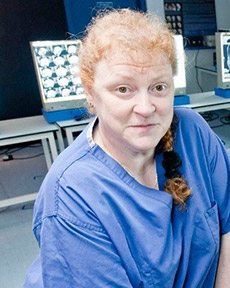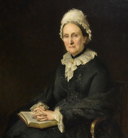
-
Celebrations begin to commemorate 50 years of the University of Dundee
2017 -
The University of Dundee becomes a fully independent institution under the terms of the Royal Charter.
1967 -
Ordinances issued in 1897 made University College form part of St Andrews. and establish a Faculty of Medicine.
1897 -
The Deed formally creating University College Dundee was signed by founders Miss Mary Ann Baxter and her cousin Dr John Boyd Baxter.
1881
Scientific Women
-
date
Fri, 03 Nov 2017
-
Running Time
00:05:58
Dundee is famous for its strong women – and none have made such an impact as the scientific heroes of the city.
Episode Transcript
Dundee is famous for its strong women – and none have made such an impact as the scientific heroes of the city. At the University of Dundee we even have a festival called Women In Science – the only such festival in the UK.
One of these women, Williamina Stevens, was born in Dundee in 1857. At the age of twenty, she married James Orr Fleming, and worked as a teacher briefly before the couple emigrated to Boston, USA, the following year. When James Fleming abandoned her and her child, she found work as a maid in the home of Professor Edward Charles Pickering, who was director of the Harvard College Observatory. Over time, Pickering came to appreciate Stevens’ efficiency and it is said he was heard to complain about his scientists, "My Scottish maid could do better!"
Pickering hired Fleming to join the Observatory where he taught her to analyze stellar spectra. She was the first woman taken on there as a so-called “human computer”. Fleming created a star classification based on their hydrogen content.
Fleming contributed to the Henry Draper Catalogue of stars and over nine years of work, she catalogued in excess of 10,000 stars and discovered 59 gaseous nebulae, over 310 variable stars, and 10 novae.
In 1888, Fleming discovered the Horsehead Nebula, However, as was often the case, subsequent professional publications did not give credit for the discovery. Despite this, by 1886, Fleming was in charge of a team of dozens of women at the observatory. In 1899, she was made Curator of Astronomical Photographs at Harvard, and in 1906, she was made an honorary member of the Royal Astronomical Society of London and then honorary fellow in Astronomy of Wellesley College.
Doris Mackinnon was born in Scotland in 1883 and she went on to study Botany and Geology at Aberdeen University, receiving her B.Sc. in 1906 with a distinction. She was awarded the prestigious "Carnegie scholarship", which allowed her to study for a year in Munich. After various high profile research positions, Mackinnon returned to Aberdeen in 1908, where she became an assistant to John Arthur Thomson at Aberdeen University. In 1909, she was made an assistant to D'Arcy Thompson at University College, Dundee, where she worked on her thesis "Studies on protozoa", which she submitted to Aberdeen University in 1914, receiving her doctorate. Within two years, Mackinnon was promoted to lecturer in Dundee. During the First World War, Mackinnon was very involved with the war effort, particularly with the diagnosis of amoebic dysentery. Following the war, Mackinnon became the acting head of the Zoological department at Dundee and then went on to become a lecturer at Kings College, London where she was promoted to reader two years later. Ultimately, she became head of Zoology. During the 1930s, two genus of protozoa, Dorisa and Dorisiella, were named after Mackinnon in recognition of her work. Mackinnon retired in 1949 and was then elected professor Emeritus of Kings College.
Margaret Fairlie was born in 1891 and was a well-regarded Scottish academic and gynaecologist. In 1920 she began a teaching career at Dundee's Medical School, which lasted for almost four decades. In 1926 she visited the Marie Curie Foundation in Paris and as a result, began to use radium to treat malignant gynaecological diseases and thus pioneered its clinical use in Scotland.
In 1936 Fairlie became head of Dundee Royal Infirmary's Obstetrics and Gynaecology Department. Four years later after a political impasse, she was finally appointed as Professor of Obstetrics and Gynaecology at the University of St Andrews. She held this post until her retirement in 1956 when she was still the only female professor in Scotland.
Today the University has invested in Athena Swan, which shows the commitment to the progression of women in academic careers in STEMM subjects and was awarded the Bronze Award in 2014. STEMM stands for Science technology engineering mathematics and medicine.
Sue Black

Professor Sue Black was born in Inverness and educated at Inverness Royal Academy.
In 1982 she was awarded a Bachelor of Science with Honours in human anatomy from the University of Aberdeen. She later went on to earn her Doctor of Philosophy in human anatomy for her thesis on 'Identification from the human skeleton', also from the University of Aberdeen.
In 1987, she took up the post of lecturer in Anatomy at St Thomas' Hospital, London, starting her career in forensic anthropology, she served in this role until 1992.
Between 1992 and 2003 she undertook various contract work for the United Kingdom's Foreign and Commonwealth Office and the United Nations, involving the identification of victims and perpetrators of various conflicts.
In 1999, she became the lead forensic anthropologist to the British Forensic Team in Kosovo, deployed by the Foreign and Commonwealth Office on behalf of the United Nations.
In 2003 she undertook two tours to Iraq and in 2005 she participated in the United Kingdom's contribution to the Thai Tsunami Victim Identification operation, as part of the 2004 Indian Ocean earthquake and tsunami international response.
In 2003, Black was appointed Professor of Anatomy and Forensic Anthropology at the University of Dundee. In 2008, she was appointed as head of the newly created Centre for Anatomy & Human Identification at the University of Dundee (CAHID).
Professor Black is past President of the British Association of Human Identification (BAHID), and the current President of Association for Science Education (Scotland).
-
Celebrations begin to commemorate 50 years of the University of Dundee
2017 -
The University of Dundee becomes a fully independent institution under the terms of the Royal Charter.
 1967
1967 -
Ordinances issued in 1897 made University College form part of St Andrews. and establish a Faculty of Medicine.
1897 -
The Deed formally creating University College Dundee was signed by founders Miss Mary Ann Baxter and her cousin Dr John Boyd Baxter.
 1881
1881